

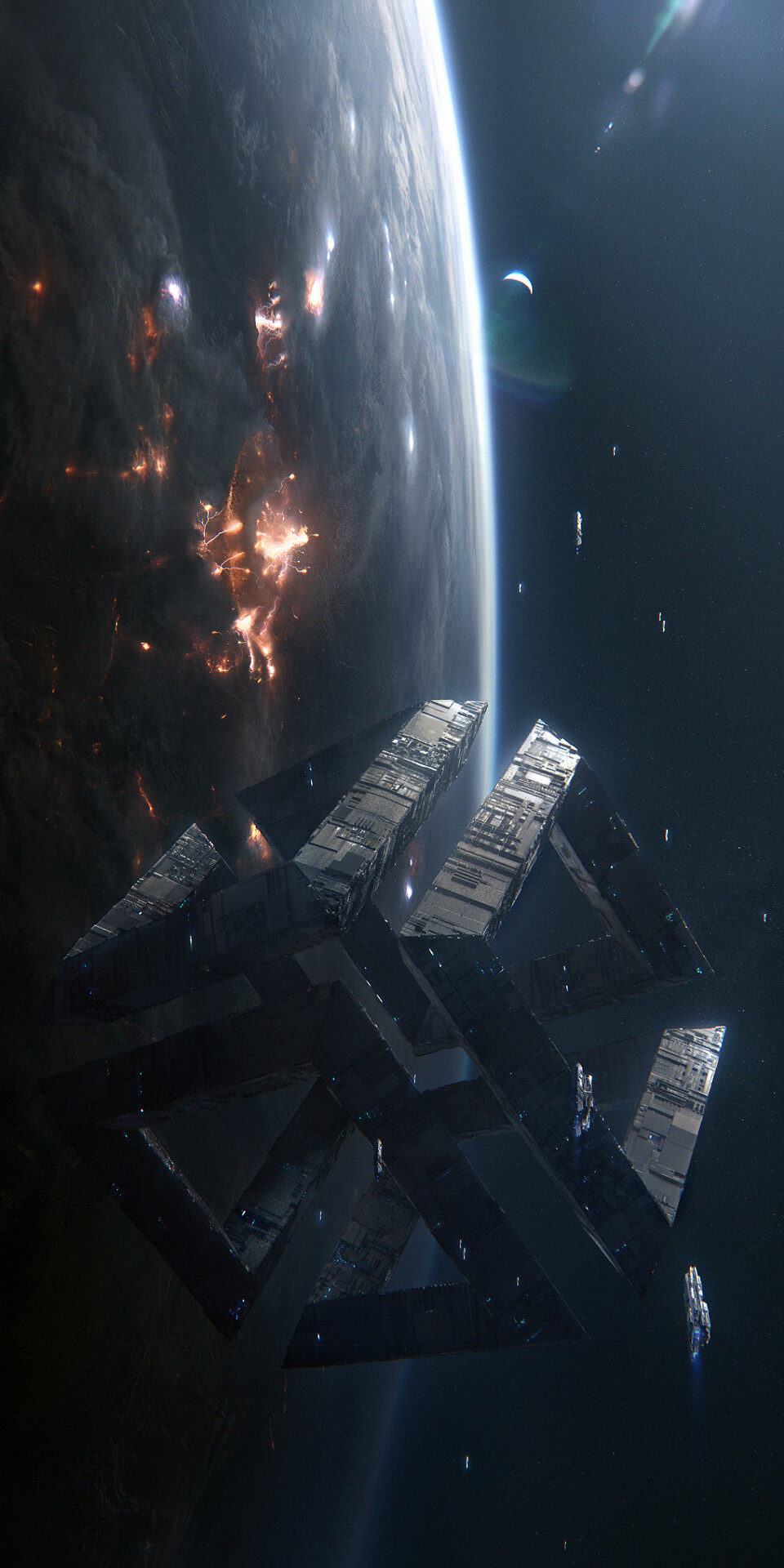
Isaac Arthur
The Megastructure Compendium
Science & Futurism
In the future humanity may build enormous structures, feats of mega-engineering that may rival planets or even be of greater scope. This episode catalogs roughly 100 major types of Megastructure, from those that are cities in space to those that rival galaxies.

Es Devlin
Blueskywhite
Devlin’s latest installtion is ‘BLUESKYWHITE’, a large-scale work commissioned by 180 Studios, which is currently showing at LUX: New Wave of Contemporary Art, a new exhibition co-curated by Fact and SUUM Project. The work combines light, music and language, and was conceived as a sculptural expression of our emotional response to the possible extinction of blue sky. The installation is formed of two parts: In Part I, text from Byron’s 1816 poem Darkness underscores the viewer’s passage through a 24m long red-lit tunnel. Part II draws from contemporary solar geo-engineering models documented by Elizabeth Kolbert and others which suggest that a haze of suspended particles might reduce global temperature to pre-industrial levels and might also turn the blue sky white.

Tomas SARACENO
توماس ساراسينو
托马斯·萨拉切诺
トマスサラセーノ
Space elevator / Spark
Black polyester rope, plastic cable ties, metal frame.
Having studied as an architect, Tomas Saraceno incorporates physics, engineering, and aeronautics into his interactive and evolving artistic structures. Using arachnology, or the study of spiders, to create structures that suggest alternative ways of living, he employs tridimensional webs to better understand how unique building blocks create distinct forms. Saraceno places spiders in cubic frames and leaves them to spin webs, rotating the cubes at various intervals to introduce elements of freedom

HYE YEON NAM
Please Smile
File Festival
“Please smile” is an exhibit involving five robotic skeleton arms that change their gestures depending on a viewer’s facial expressions. It consists of a microcontroller, a camera, a computer, five external power supplies, and five plastic skeleton arms, each of them with four motors. It incorporates elements from mechanical engineering, computer vision perception, to serve artistic expression with a robot.

Bjarke Ingels
BIG
Vancouver House (twisting tower)
“we would build the building literally two feet off center, and as we poured each form, slowly the building would come back to center. it’s an incredible engineering feat of both horizontal and vertical post-tension.” Buro Happold

REVITAL COHEN & TUUR VAN BALEN
The Immortal
A number of life-support machines are connected to each other, circulating liquids and air in attempt to mimic a biological structure.
The Immortal investigates human dependence on electronics, the desire to make machines replicate organisms and our perception of anatomy as reflected by biomedical engineering.
A web of tubes and electric cords are interwoven in closed circuits through a Heart-Lung Machine, Dialysis Machine, an Infant Incubator, a Mechanical Ventilator and an Intraoperative Cell Salvage Machine. The organ replacement machines operate in orchestrated loops, keeping each other alive through circulation of electrical impulses, oxygen and artificial blood.
Salted water acts as blood replacement: throughout the artificial circulatory system minerals are added and filtered out again, the blood gets oxygenated via contact with the oxygen cycle, and an ECG device monitors the system’s heartbeat. As the fluid pumps around the room in a meditative pulse, the sound of mechanical breath and slow humming of motors resonates in the body through a comforting yet disquieting soundscape.Life support machines are extraordinary devices; computers designed to activate our bodies when anatomy fails, hidden away in hospital wards. Although they are designed as the ultimate utilitarian appliances, they are extremely meaningful and carry a complex social, cultural and ethical subtext. While life prolonging technologies are invented as emergency measures to combat or delay death, my interest lies in considering these devices as a human enhancement strategy.This work is a continuation of my investigation of the patient as a cyborg, questioning the relationship between medicine and techno- fantasies about mechanical bodies, hyper abilities and posthumanism.
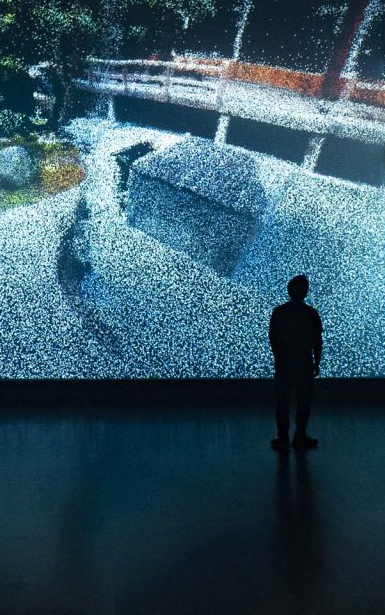
Stillness
THINK AND SENSE
Under the theme of Zen, this artwork represents a part of the philosophy of Zen with three-dimensional data created with photogrammetry technology composed of the most minimalistic landscape of “dots” and the soundscape of “undulations,” with the cooperation of Toryo Ito, vice priest of Ryosokuin, Kennin-ji Tacchu temple, Kyoto. The generated image reflecting the environmental information of the exhibition space creates “interaction between the environment and the image,” just like the trees and leaves swinging in the silence in the garden of a Zen temple.
.
Credit Concept / Technical Direction: Shuhei Matsuyama Point Cloud System Design:Takamitsu Masumi Sound Design: Intercity-Express (Tetsuji Ohno) Photogrammetry Shooting: Naoya Takebe Photogrammetry Engineering: Katsuya Sakuma

JIM CAMPBELL
led-explosion
“Jim Campbell (b1956) is a San Francisco-based artist who has embraced the connections of light, space and time, as few others have. He uses LED technology and his skills in electrical engineering to masterfully achieve what Andrei Tarkovsky called “sculpting in time”. He introduces the illusions and our minds complete them.” DARRAN ANDERSON
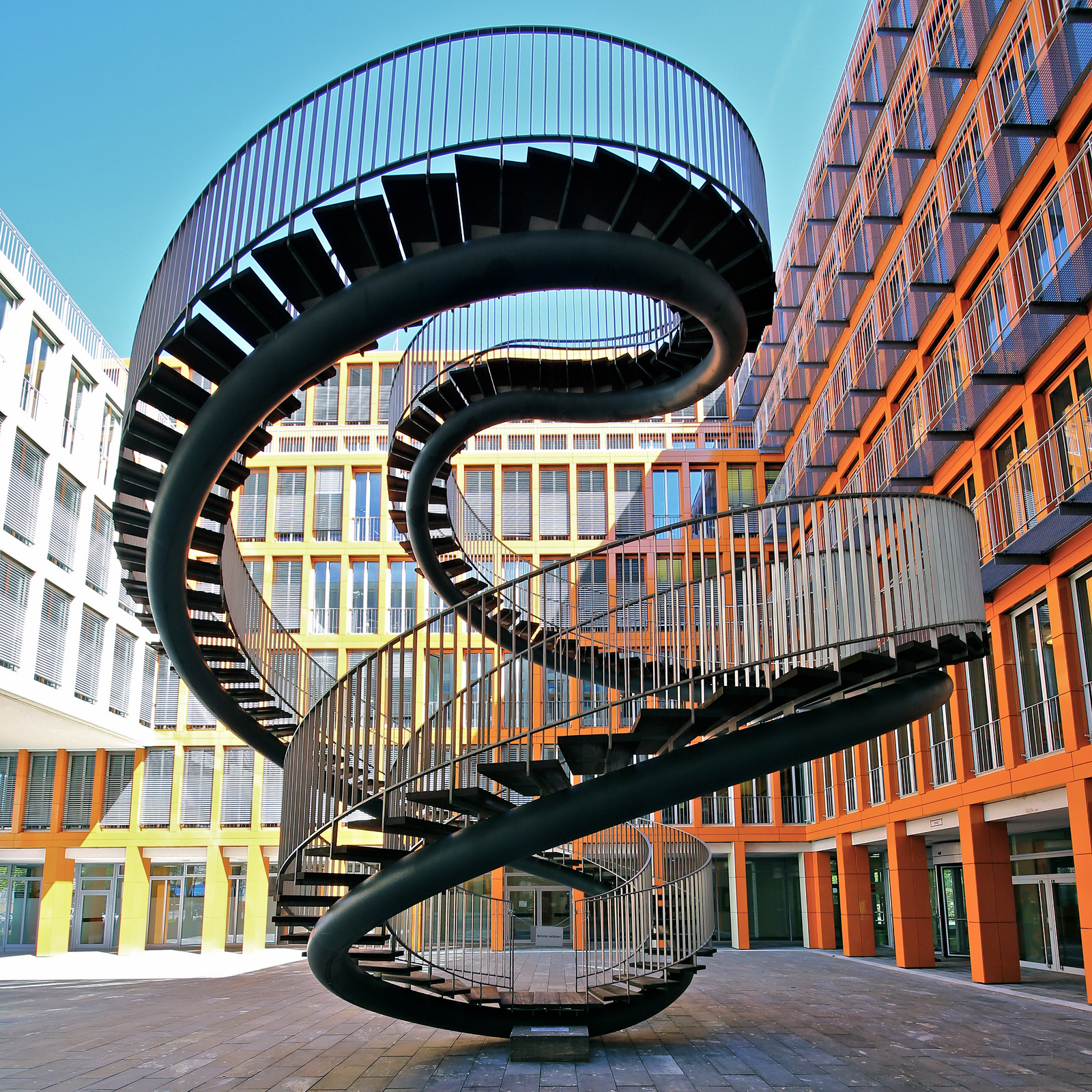
OLAFUR ELIASSON
オラファー·エリアソン
اولافور الياسون
奥拉维尔·埃利亚松
אולאפור אליאסון
Олафур Элиассон
Infinite Staircase (Umschreibung)
Permanently installed in the atrium of an office building in Munich, two spiral staircases interlock with each other, creating a continuous loop in the form of a double helix. To plan the work, a double helix was projected onto the surface of a sphere. The heights of the steps vary slightly to compensate for the curvature of the staircases, growing shallower at the poles. Precise engineering was necessary to enable the structure to balance on one point.
The continuous loop of Umschreibung contrasts starkly with the office courtyard in Munich where it is installed. Umschreibung – which can be translated as ‘circumscription’ or ‘periphrasis’ – proposes a movement without destination, a space defined by motion rather than walls.

Wyss Institute, SEAS & Boston University
Microfluidic Origami for Reconfigurable Pneumatic/Hydraulic (MORPH)
Looking to create a robot smaller than a centimeter that might someday perform precision surgery or help destroy tumors, researchers from Harvard University’s Wyss Institute and School of Engineering and Applied Sciences (SEAS), and Boston University looked to nature for inspiration, and developed a novel microfabrication technique to construct it. Their tiny robot looks like a rubbery, transparent spider — and in fact, the team modeled the form after Australia’s famously colorful and captivating peacock spider.

Martin and Erik Demaine
Fuller Craft Series
“On the one hand, we have some very interesting geometric sculpture. And, on the other hand, we are growing our understanding of these forms that ultimately will lead to some scientific and engineering applications,” he says. “Our sculptures also represent a different way of communicating with the public. For scientists, it’s another medium to communicate that there are both interesting and beautiful things in science and math.”
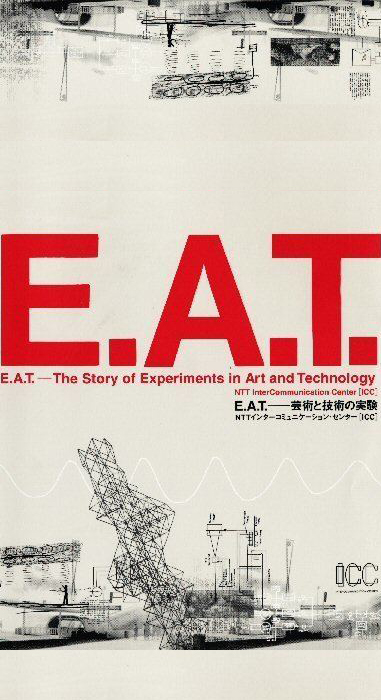
E.A.T
E.A.T
Experiments in Art & Technology
In 1966, 10 New York artists worked with 30 engineers and scientists from the world renowned Bell Telephone Laboratories to create groundbreaking performances, known as 9 Evenings: Theatre and Engineering. Artists included Andy Warhol, John Cage, Lucinda Childs, Vyvind Fahlstrvm, Alex Hay, Deborah Hay, Steve Paxton, Yvonne Rainer, Robert Rauschenberg, David Tudor, and Robert Whitman. Notable engineers involved include: Bela Julesz, Billy Kluver, Max Mathews, John Pierce, Manfred Schroeder, and Fred Waldhauer.

Anouk Wipprecht
Dutch based designer Anouk Wipprecht is working in the emerging field of “fashionable technology”; a rare combination of sartorial knowhow combined with engineering smarts and style, she has in a very short period created an impressive body of tech-enhanced designs bringing together fashion and technology in an unusual way. She creates technological couture; with background in fashion design combined with engineering, science and interaction design, she creates systems around the body that tend towards artificial intelligence; projected as ‘host’ systems on the human body, her designs move, breath, and react to the environment around them.

Keith Lemley
Keith Lemley is a sculpture artist whose work focuses on creating an informative relationship between object and space and challenges the physicality of material presence. Many of his works are made up of opposing forces of ephemeral light and structural woodblocks that unite in a metaphorical existence of natural systems. His background in science and engineering is reflected in the unique synthesizing of media that portray scenes from nature and memory and inspire a sense of exploration for the viewer.

Lebbeus Woods
ЛЕББЕУС ВУДС
レベウス・ウッズ
Horizon Houses
“The engineering questions of how to turn the houses could be answered by conventional mechanical means—cranes and the like—but these seem clumsy and inelegant. The mechanical solution may lie in the idea of self-propelling structures, using hydraulics. But of more immediate concern: how would the changing spaces impact the ways we might inhabit them?” more…
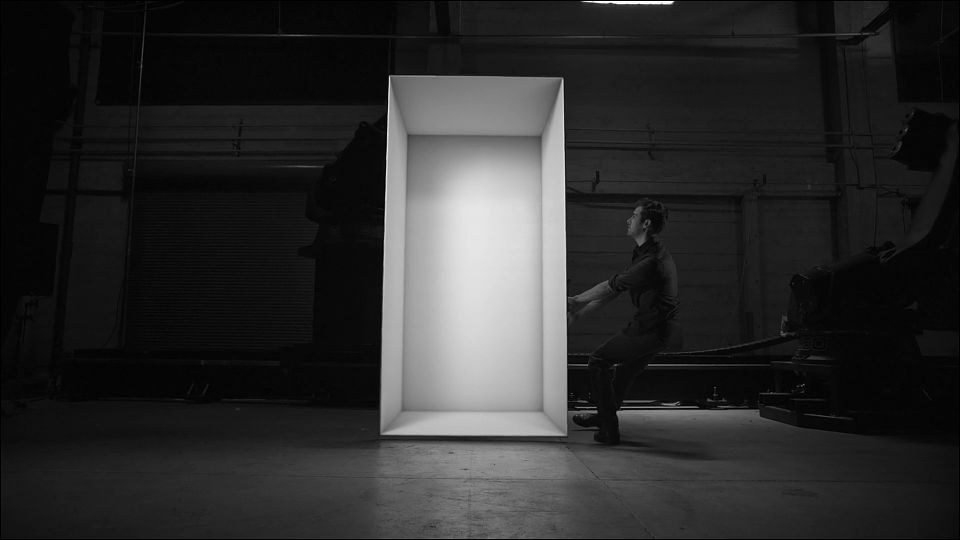
BOT & DOLLY
box
Bot & Dolly is a design and engineering studio that specializes in automation, robotics, and filmmaking. It’s our mission to advance motion control and automation as a creative medium, and build world-class tools that enable others to do the same. At the core of our technology is an integrated software/hardware platform that provides precise and expressive control of 6-axis industrial robots. On top of this core platform we provide industry-specific toolsets such as IRIS to support in the creative process, from prototype to production. To date, our tools have been used in feature films, national television ads, Las Vegas shows, and large-scale art installations. We dream about where they’ll be used next.
.

JONTY HURWITZ
Anamorphic sculpture
London-based artist Jonty Hurwitz creates ‘Anamorphic Sculptures’ which only reveal themselves once facing a reflective cylinder. Hurwitz took an engineering degree in Johannesburg where he discovered the fine line between art and science. He has lived in England for many years, working in the online industry though he quietly levitated into the world of art inspired by a need to make ‘something real’. Hurwitz discovered that he could use science as an artistic paintbrush. Each of his sculptures is a study on the physics of how we perceive space and is the stroke of over 1 billion calculations and algorithms.
.

BERNIE LUBELL
Conservation of Intimacy
Made of pine, latex, music wire, copper, nylon line, paper, pens and video surveillance. It measured 20′ x 35′ x 26′ at Southern Exposdure.
A couple rocking on the bench sends air pulses to another room causing balls to move and pens to transcribe their motions onto paper. The paper is moved by a third person on a stationary bike. The couple on the bench can watch the balls on a video monitor before them where the balls appear to bounce into the air. The motion is delayed and languid as though under water. Action is best when the couple is moving slowly together. As visitors work together to animate the mechanisms, they create a theatre for themselves and each other. By encouraging participation, and touch the pieces coax visitors to engage their bodies as well as their minds. The way that pieces move and feel and sound as you rock them, pedal, crank and press against them applies the kinesthetic comprehension’s of childhood to the tasks of philosophy. Bernie Lubell’s interactive installations have evolved from his studies in both psychology and engineering. As participants play with his whimsical wood machines, they become actors in a theater of their own imagining.

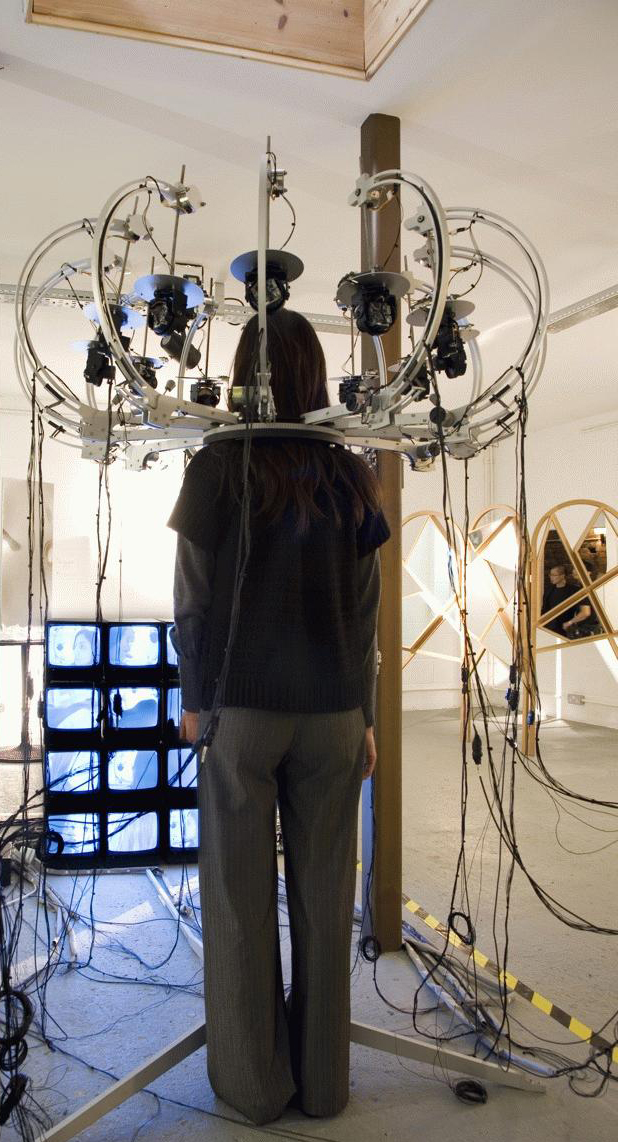
Hwang Kim
CCTV chandelier
“CCTV Chandelier : Virtual Doppelganger Simulator” is an interactive installation that can reflect viewer’s Virtual Doppelganger. You can look objectively into yourself in a third person’s point of view.
This machine have around 12 CCTVs surrounding and hanging near viewer’s face and engineering viewer’s experience to show their Virtual Doppelganger in the connected monitors. This wearable visual system then allows the participant to see his/her own body or the surrounding environment from a third person’s perspective even when he/she is moving. Therefore, you yourself, viewer and visitor is displayed as an object in the gallery.

Eve Bailey
ИВ БЭЙЛИ
Tongue in Cheek
My work is based on the concepts of balance and coordination. The body interests me as a perceiving mechanical structure. I use my own body as a primary tool to create pieces that experiment with equilibrium through physical, mechanical, plastic and conceptual means. My studio practice is rooted in the tradition of the artist engineer. I design and build suspended and pendular constructions that can sustain their own weight and mine as I perform with them. By climbing and inverting on the structures, I challenge my own perception and creative process.
With the combination of the two mediums sculpture and performance, I seek balance in the mind versus body relationship. My work alternates between theory and practice. The intellect occurs in the engineering of my structures and the sensuality arises from my body in motion, bringing together two talents commonly thought as disparate: male versus female, rational versus instinctive. All my pieces are created upon contrastive ideas and principles. I constantly play with contradictions whether they are of visual, physical or conceptual nature.
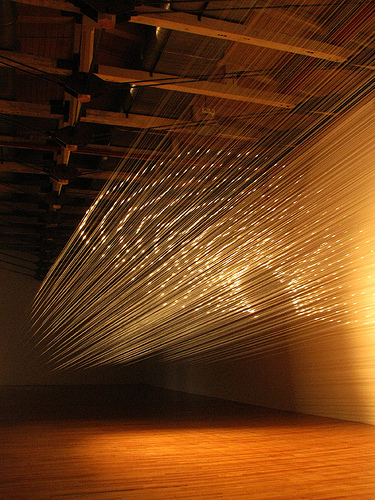
Tobias Putrih
Re-projection: Hoosac
Influenced by the utopian projects — and notable failures — of innovative artists and designers such as Buckminster Fuller, Frederick Kiesler, and Charles Eames, Tobias Putrih likens his works to experiments, or design prototypes. His use of cheap materials, including egg crates, cardboard, and plywood signify both a sense of potential and impending collapse. Many of the artist’s works reference the architecture and spectacle of the cinema: a space suspended between fantasy and reality, image and environment. With Re-projection: Hoosac Putrih distills the cinema to its most basic element: fishing line stretched across the gallery mimics the conical trajectory of a beam of light. A spotlight hits the strands of monofilament which in turn become a screen, reflecting an image in illuminated dots. Inspired by the Hoosac Tunnel just east of North Adams — a storied, engineering marvel that draws ghost-hunters to the area — Putrih’s tunnel is, likewise, both real and a representation, an optical trick that invites both wonder and investigation.

YURI SUZUKI
尤里铃木
يوري سوزوكي
beatvox
File Festival
By EPFL + ECAL lab in collaboration with Yuri Suzuki Direction: Nicolas Henchoz Designer: Yuri Suzuki Engineering: Gavrilo Bozovic, Fanny Riedo Software development: Gavrilo Bozovic, Fanny Riedo, Eric Morzier A microphone-controlled drumkit. Renowned as an artist for his projects questioning the materiality of sound, Yuri Suzuki has his own way of looking at augmented reality. For Berlin, he is creating an installation which will enable anyone to control a set of drums with their own voice. He harnesses the principles of augmented reality to interpret them in the realm of sound.

Buckminster Fuller
Tensegrity Sphere
Sixty-Strut Tensegrity Sphere by Buckminster Fuller is both a feat of engineering and an object of beauty. Wire individually snakes through sixty stainless steel tubes, suspending them in a icosahedral (20 face) form. Tensional integrity, or tensegrity – a term coined by Fuller – is a structural-relationship principle.
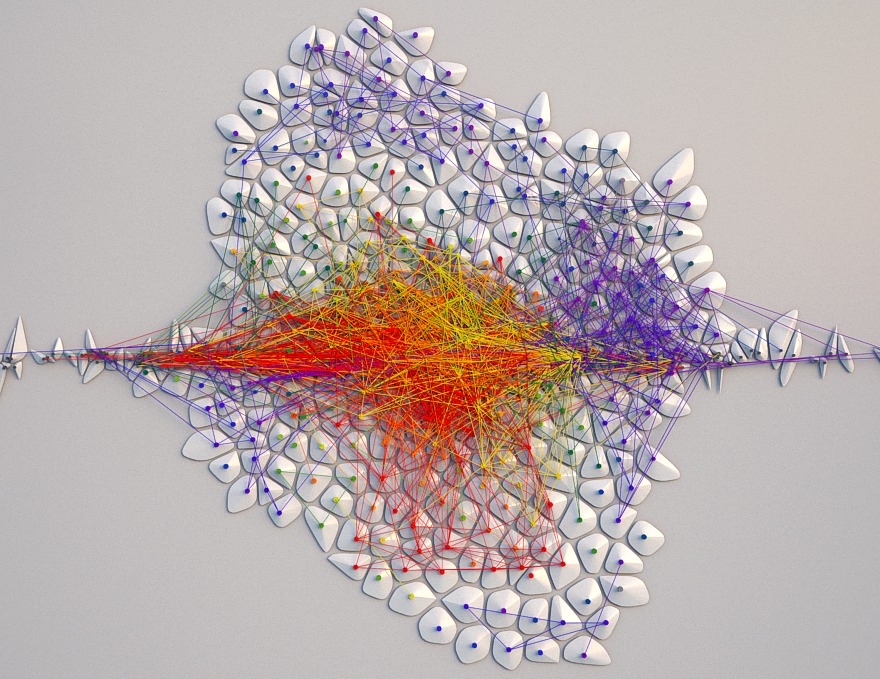
GIUSEPPE RANDAZZO
Джузеппе Рандаццо
transmutation
Transmutation#01 is a generative system composed of two interacting multicellular agents in a Voronoi spatial configuration. Each cell owns a color/saturation information. The cells interact with each other and with the other agent. The two agents are different. The circular one, the most active and in evolution, constantly tries to reorganize its shape and color structures, connecting similar colors in concentric formations. Moreover the saturation and shape of its colors aggregates are influenced by the duration and proximity of the interaction with the other pluricellular agent, whose motion is abstract and immutable. The metaphor at the heart of this system is a reference to the subject of the 2012 Gender Docufilm Festival in Rome, from which the video was commissioned, that precisely addresses the issues related to the the reengineering and the transmutation of the sexual, physical, mental identity, through the collision / confrontation with the external reality. Coded with Processing, rendered with 3Delight (via Processing). In collaboration with Filippo Ulivieri, music by Massimo Dolce.

ANNA WILKINSON
Sculptural Simulacrum
“..Inspiration for this project comes from digital sculpture that created by sculptors who use specialized software to create their work.
In my literature review, I was fascinated to learn how much engineering and math are often involved in digital sculpture and to learn that the process of digital sculpturing has many similarities to pattern making which also relies heavily on mathematic, angles, and precise measurements…” “…One of the most inspiring digital sculptors for me was “Basheba Grossman”. I enjoyed many of his pieces, but was especially inspired from his digitally created bronze knots. In addition to the precise geometry of the knot sculptures, something which, even with the naked eye, it’s apparent that the knots are precise symmetrical pieces. What is also fascinating about the knots is that they exist simultaneously as different shapes that still occupy a single space! Collectively the knots form a sphere, or suggest a cycle or globe, yet the components of the knots are often more like bent stretching disc or arms. The knots have no visible foundation, it is impossible to see where the “starting point” and the “ending point” or even the edges of the sculpture exist..”
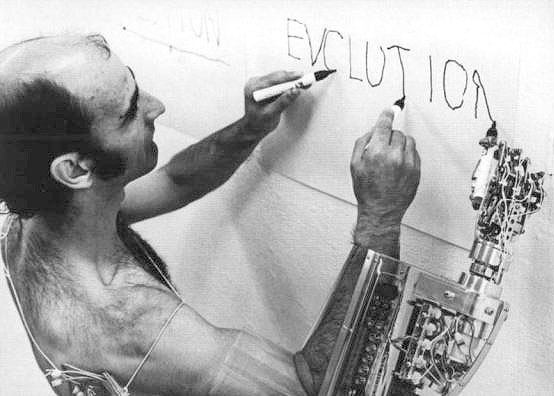
STELARC
drawing with robot arm
“With gene mapping, gender reassignment, prosthetic limbs and neural implants, what a body is and how a body operates becomes problematic. We generate Fractal Flesh and Phantom Flesh, extended operational systems and virtual task environments. Meat and metal mesh into unexpected and alternate anatomical architectures that perform remotely beyond the boundaries of the skin and beyond the local space it inhabits. The monstrous is no longer the alien other. We inhabit an age of Circulating Flesh. Organs are extracted from one body and inserted into other bodies. Limbs that are amputated from a dead body can be reattached and reanimated on a living body. A face from a donor stitched to the skull of the recipient becomes a Third Face. A skin cell from an impotent male can be recoded into a sperm cell. And more interestingly a skin cell from a female body might be recoded into a sperm cell. Turbine hearts circulate blood without pulsing. In the near future you might rest you head on your loved one’s chest. They are warm to the touch, they are breathing, they are certainly alive. But they will have no heartbeat. A cadaver can be preserved forever through plastination whilst simultaneously a comatose body can be sustained indefinitely on a life-support system. Dead bodies need not decompose, near-dead bodies need not die. Most people will no longer die biological deaths. They will die when their life-support systems are switched off. The dead, the near-dead, the not-yet-born and the partially living exist simultaneously. And cryongenically preserved bodies await reanimation at some imagined future. We live in an age of the Cadaver, the Comatose and the Chimera. Liminal spaces proliferate. Engineering organs, stem-cell growing them or by bio-printing will result in an abundence of organs. An excess of organs. Of organs awaiting bodies. Of Organs Without Bodies.” STELARC